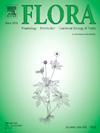两种树种的吸收根和运输根对土壤盐度的响应不同
IF 1.8
4区 生物学
Q3 ECOLOGY
引用次数: 0
摘要
盐碱化是严重影响世界沿海地区森林生态系统稳定性的因素之一,它限制了森林根系的生长,对森林的发展产生不利影响。木本植物的细根可分为吸收根和运输根;然而,它们对盐碱化的响应及其潜在的适应机制尚不清楚。其中,Styphnolobium japonicum (L.)的吸收和运输根采集黄河三角洲不同土层的肖特和刺槐,分析其功能性状的变化。吸收根的呼吸速率(RR)、比根长和比根面积(SRL和SRA)、氮含量高于运输根,但根径(RD)、组织密度(RTD)和干物质含量低于运输根。总体而言,与未盐渍化根相比,盐渍化吸收根的RR较高,SRL和SRA较低,而运输根则相对保守。刺槐对土壤盐渍化的敏感性高于刺槐。此外,随着土壤深度的增加,吸收根的SRL、RR和氮含量的响应更大,而运输根的RD和RTD的变化更大。这些结果表明,在对土壤盐分的响应中,吸收根的获取策略比运输根的保守策略更有利于资源的获取。我们的研究结果也暗示了在生态进程中应用基于根功能的分类对于理解根资源觅食策略的重要性。本文章由计算机程序翻译,如有差异,请以英文原文为准。
Absorptive and transport roots of two tree species respond differently to soil salinity along soil depth
Salinization is one of the factors seriously affecting the stability of forest ecosystems in coastal areas worldwide, which limits root growth and has adverse effects on forest development. Fine roots of woody plants can be divided into absorptive and transport roots; however, their responses to salinization along soil layers and the potential adaptation mechanisms remain unclear. Herein, absorptive and transport roots of Styphnolobium japonicum (L.) Schott and Robinia pseudoacacia L. in Yellow River Delta were collected in different soil layers, and their functional trait variations were analyzed, respectively. Absorptive roots exhibited greater respiration rates (RR), specific root length and area (SRL and SRA), nitrogen content, but lower root diameter (RD), tissue density (RTD), and dry matter contents than transport roots. Generally, compared with non-salinized roots, salinized absorptive roots had higher RR, lower SRL and SRA, while transport roots were relatively conservative. Robinia pseudoacacia was more sensitive to soil salinization than S. japonicum. Additionally, with the increase of soil depth in both sites, greater responses of SRL, RR, and nitrogen content were found in absorptive roots, whereas larger changes of RD and RTD in transport roots. These results highlight that the acquisitive strategy of absorptive roots, rather than the conservative strategy of transport roots, facilitates resource acquisition in responding to soil salinity. Our findings also imply the importance of applying root functional-based classification in the ecological progress for understanding the root resource foraging strategies.
求助全文
通过发布文献求助,成功后即可免费获取论文全文。
去求助
来源期刊

Flora
生物-植物科学
CiteScore
3.30
自引率
10.50%
发文量
130
审稿时长
54 days
期刊介绍:
FLORA publishes original contributions and review articles on plant structure (morphology and anatomy), plant distribution (incl. phylogeography) and plant functional ecology (ecophysiology, population ecology and population genetics, organismic interactions, community ecology, ecosystem ecology). Manuscripts (both original and review articles) on a single topic can be compiled in Special Issues, for which suggestions are welcome.
FLORA, the scientific botanical journal with the longest uninterrupted publication sequence (since 1818), considers manuscripts in the above areas which appeal a broad scientific and international readership. Manuscripts focused on floristics and vegetation science will only be considered if they exceed the pure descriptive approach and have relevance for interpreting plant morphology, distribution or ecology. Manuscripts whose content is restricted to purely systematic and nomenclature matters, to geobotanical aspects of only local interest, to pure applications in agri-, horti- or silviculture and pharmacology, and experimental studies dealing exclusively with investigations at the cellular and subcellular level will not be accepted. Manuscripts dealing with comparative and evolutionary aspects of morphology, anatomy and development are welcome.
 求助内容:
求助内容: 应助结果提醒方式:
应助结果提醒方式:


